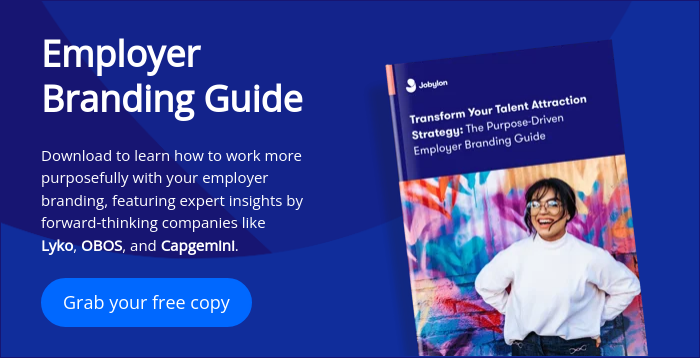Job ads are not a new concept. In fact, they’ve been around for as long as jobs themselves. However, a combination of technology and process changes has transformed the world of work, and job ads have not remained unaffected. From jobs advertised in newspapers to today’s digital job ads, a lot has already changed and evolution is not expected to slow down anytime soon. Candidates expect jobs ads to be on par with ads targeted to consumers, so employers need to keep applying the latest marketing best practice to hire the best talent. While 2020 is an employers’ market, top candidates are always in demand, and with 14 seconds to attract them with your job ads, the clock is ticking!
Let’s start by exploring some of the issues of most job ads currently in the market to understand areas for improvement before providing you with all the upcoming trends that are shaping the job ad of the future.

Job Ad Challenges
#1 Employer-focused
It is common marketing knowledge that an advert should focus on its target audience. However, it is baffling that this concept seems to be forgotten when it comes to job ads, as the vast majority of the content usually included is focused on the employer. Lengthy lists of duties & responsibilities, irrelevant detailed descriptions of the department where the role belongs, and large chunks of text listing the employer’s products/services, achievements, values, mission, and vision, are likely to alienate prospective applicants.
#2 They are impersonal
Most jobs ads are identical in their structure, format, and even content when promoting similar jobs. Employers rarely use their brand, employees, and hiring managers to show their human face, a deciding factor for a prospective candidate. A job ad is an organization’s only chance to get personal with candidates and convince them to submit an application, as data from the Candidate Experience Awards shows that 48% of all applicants have no prior relationship with target companies, highlighting this missed opportunity.
#3 Lack of (meaningful) information
While most job ads are lengthy, they lack relevant information. It is paramount to illustrate the benefits for candidates using text, images, and videos. Creating most content based on your candidate persona will allow your target audience to make an informed decision when it comes to applying, bringing you more quality applicants. After presenting key areas for improvement, let’s move on to the solutions that shape the top job ad trends.
Job Ad Trends
1. Candidate-centric job ads
Candidate experience is imperative. To achieve enhancements in this area, shift the focus to applicants, explaining what’s in it for them. Further, make sure the application process is short, fast, and smooth.
Some employers are of the opinion that job ads should focus on the role, while others put the emphasis on the business. In reality, it is important to cover both equally by providing detailed information to inform prospective applicants. Content should cover the vacancy’s scope of work and purpose, the product or service of the organization and how it relates to the role, the current circumstances and future plans of the business, and the culture with a focus on the employee experience. The combination of this information can enable candidates to get the required clarity without having to do a lot of unnecessary homework.
On a related note, effective job ads are succinct, concise, and to the point. Instead of copy-pasting generic skills set to find that applicants are not qualified for the actual role, it is beneficial to take the time and tailor the requirements to your needs. Make sure you provide information reflective of the opportunity, including a range of salary, instead of the dreadful $DOE. Lastly, research has shown that prospective candidates are more likely to apply to short ads, while lengthy chunks of texts can drive them away. In summary, keep it short!
Apart from creating candidate-centric content, the functionality of your recruitment software should contribute to a stellar application experience. Having to navigate different pages, register, and invest time and effort is likely to have a negative impact on the experience of your candidates. Instead, look for an applicant tracking system that offers candidates the ability to apply without registration in a few simple clicks.
2. Increased use of brand elements
Nowadays, companies allocate hefty budgets for employer branding, as it is proven that it can elevate recruitment. However, the job ad remains a severely under-utilized channel to communicate this brand, as most recruitment tools offer limited functionality in this respect. Forward-looking, sophisticated tools offer the ability to showcase your employer brand in a multitude of ways.
Some of the options to brand your job ads include unique fonts, colors, and icons. The advanced software offers the ability to go a step further by presenting information visually using images and videos. Lastly, don’t forget to incorporate your logo in key areas to ensure a consistent look and feel with the rest of your website.
In terms of content, we recommend staying away from general information about and achievements of your business. Instead, focus on how you are a great employer, detailing what matters to prospective applicants. This includes information on current employees, career progression, and compensation & benefits.
3. Getting personal
Employees work for humans, not for companies. Even if you have cultivated a dazzling employer brand, you offer the sexiest jobs in the industry, and you provide excellent rewards, nothing will attract prospective candidates more than your current employees. Testimonials are known to have an impact on buyers’ decisions, and it is no different for candidates. Thus, look for a recruitment system that allows you to present your current workforce and showcase authentic testimonials.
Also, the hiring manager-candidate fit is one of the most important considerations for successful recruitment. While most competitors are one step behind, connecting applicants and managers at the final interview stage, savvy employers take the lead by doing so through their job ads. This can be an excellent way for candidates to self-screen themselves, which in turn will increase the number of relevant applications the employer receives.
4. Use of rich information
While in our personal lives we are used to receiving rich information, such as images and videos, this is not the case with most job adverts. This technology mismatch can have a negative impact, as candidates receive inferior quality of information than they do off work. Sophisticated recruitment applications are pioneering the use of video and images throughout the job ad, which can give employers a competitive advantage.
5. Flexibility to customize
One of the most important features of the job ad of the future is customization. While the above sections cover the key areas of evolution, we have to understand that one size does not fit all when it comes to job ads. This means there are different needs for each, industry, employer, job, and location. While employers can start from a best practice template for time efficiency, it is important to factor these needs in, so that they can tailor job ads as required for each vacancy, meeting the expectations of prospective candidates and attracting top talent!
Last updated:

